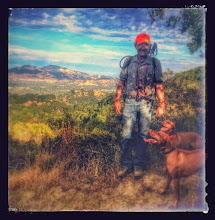Written by Dr. Kim Smyth
Staff Veterinarian and Pet Health Writer for PetPlan
Coccidioidomycosis is a fungal disease that affects humans, dogs, and sometimes cats. Also known as San Joaquin Valley Fever, coccidioidomycosis is caused by the inhalation of fungal spores.
 |
| digging in the desert around Quartzsite, Arizonia |
The fungi Coccidioides immitis and Coccidioides posadasii live in the soil and are native to areas that are hot and dry, like the southwestern United States and Mexico. Southern California, Arizona, and southwest Texas are the areas where the organisms are most prevalent, although they can also be found in New Mexico, Utah, and Nevada.
Dry and windy conditions contribute to the spread of the fungal organisms, and therefore cause an uptick in disease. Anything that disturbs the soil can rustle up these invaders, so dust storms, heavy rains, and earthquakes will do the trick, too. Late fall and winter seems to be the season of coccidioidomycosis, as the weather patterns are prime for the spread of the fungal organisms.
Clinical disease occurs when the fungal spores are inhaled, with the exception of the cases where skin disease occurs from contamination of an open wound. Primary disease occurs in the lungs, and then the yeast form of the organism can spread to the local lymph nodes and other organs. This disease does not discriminate--it can set up shop in most any organ, including the eyes, skin, heart, brain, spinal cord, spleen, liver, kidneys, testicles, and bones. If your dog has got it, coccidioidomycosis can likely affect it.
The incubation period is about one to three weeks from exposure, but the organism can remain dormant for 3 years or more! That’s why it’s important to include the history travel to these regions if your pet shows appropriate clinical signs, even if the trip was years ago.
Signs + Symptoms
Clinical signs include fever, decreased appetite, weight loss, lethargy and weakness. More specific signs will occur based on where the organism settles in the body. Bone pain will cause lameness, while disease in the eye can lead to uveitis and blindness. Seizures can occur when the central nervous system is affected, and organ failure can occur if the heart, liver, or kidneys are where the fungus calls home.
Diagnosis
Determining whether your pet is suffering from coccidioidomycosis will start with considering the clinical signs and history of travel to affected regions. Of course, if you live in one of these regions, coccidioidomycosis is already on your vet’s radar. Your vet can take a small sample from lymph nodes to look for the fungal organism, and similarly, draining tracts may yield the fungus, too. If those methods prove unrewarding, blood tests can track down the disease, too.
Treatment
Fortunately, putting affected pets on an oral anti-fungal medication for an extended period of time usually does the trick. Generally, pets are treated for at least three months (or two months past the resolution of clinical signs). The prognosis is good for pets who have contracted coccidioidomycosis; 90% of pets with local disease will respond to treatment and 60% of pets with disseminated disease will respond, though recurrence can happen at any time.
For pets who live in endemic areas, staying indoors can help prevent the disease. Studies have shown that outdoor pets are almost five times as likely to contract coccidioidomycosis, as are pets that are allowed to roam on an acre or more of land. Pets who are leash-walked on sidewalks had a decreased risk. This isn’t to say that you should keep your dog in a bubble, but maybe in the late fall and early winter, you should consider reigning them in just a bit.





















 Environments and weather conditions that tend disseminate the fungus are:
Environments and weather conditions that tend disseminate the fungus are:


















